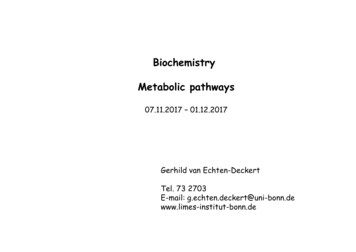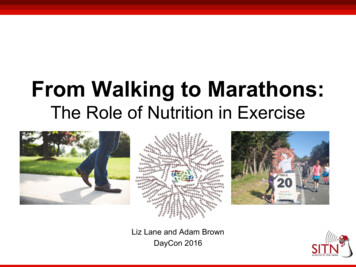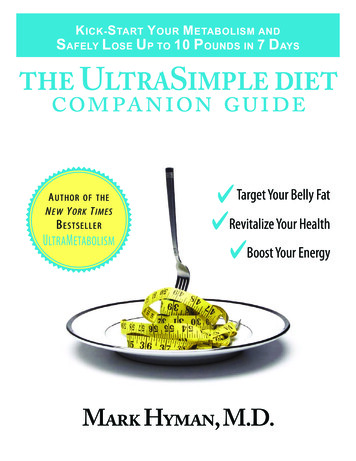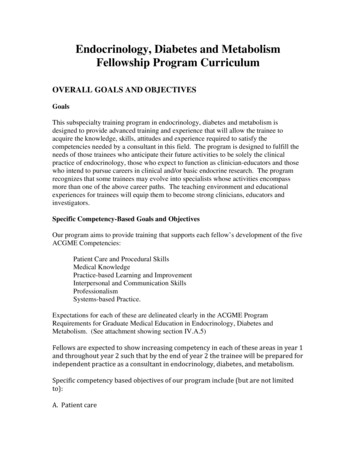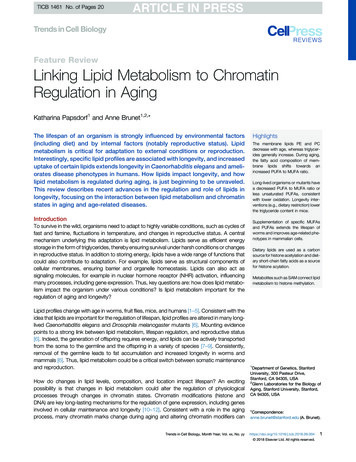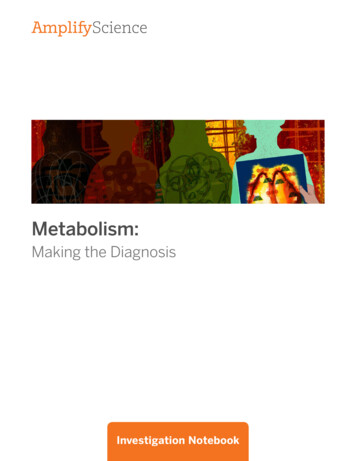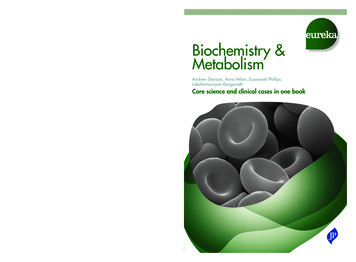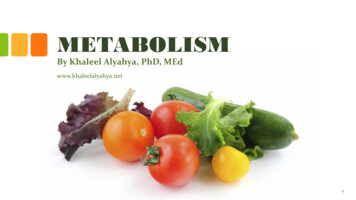
Transcription
METABOLISMBy Khaleel Alyahya, PhD, MEdwww.khaleelalyahya.net1
RESOURCES Information, tables and figures of this lecture were taken from the following books: Mastering Medical TerminologyoBy Sue Walker, Maryann Wood and Jenny Nicol Essential of Human Anatomy and PhysiologyoBy Elaine Marieb and Suzanne Keller Additional Recommended Resources: Mosby’s DictionaryoBy Mosby KENHUB Websiteowww.kenhub.comBy Khaleel Alyahya, PhD, MEd
INTRODUCTION Metabolism is a broad term referring to all chemicalreactions that are necessary to maintain life. It involves catabolism, the breakdown of substances tosimpler substances, and anabolism, the building of largermolecules or structures from smaller ones. During catabolism, bond energy of foods is released andcaptured to make adenosine triphosphate (ATP), theenergy-rich molecule used to energize all cellularactivities, including catabolic reactions.3By Khaleel Alyahya, PhD, MEd
METABOLISM IN BODY CELLS Not all foodstuffs are treated in the same way by bodycells. For example, carbohydrates, particularly glucose, areusually broken down to make ATP. Fats are used to build cell membranes, make myelinsheaths around neurons, and insulate the body with a fattycushion. They are also used as the body’s main supply for makingATP when there are inadequate carbohydrates in the diet. Proteins are the major structural materials used for buildingcell structures.4By Khaleel Alyahya, PhD, MEd
CARBOHYDRATE METABOLISM Just as an oil furnace uses oil to produce heat, the cells of the body usecarbohydrates as their preferred supply to produce cellular energy (ATP). Glucose, also known as blood sugar, is the major breakdown product ofcarbohydrate digestion. Glucose is also the major supply used for making ATP in most body cells. The liver is an exception; it routinely uses fats as well, thus saving glucose forother body cells. Essentially, glucose is broken apart piece by piece, and some of the chemicalenergy released when its bonds are broken is captured and used to bindphosphate to ADP molecules to make ATP. The carbon atoms released from glucose leave the cells as carbon dioxide, andthe hydrogen atoms removed (which contain energy-rich electrons) areeventually combined with oxygen to form water. These oxygen-using events are referred to collectively as cellular respiration.5By Khaleel Alyahya, PhD, MEd
HYPERGLYCEMIA VS. HYPOGLYCEMIA Because glucose is the major supply for making ATP,homeostasis of the blood glucose level is critically important. If there is an excessively high level of glucose in the blood(hyperglycemia), some of the excess is stored in body cells(particularly liver and muscle cells) as glycogen. If the blood glucose level is still too high, excesses areconverted to fat. There is no question that eating large amounts of empty-caloriefoods such as candy and other sugary sweets causes a rapiddeposit of fat in the body’s adipose tissues. When the blood glucose level is too low (hypoglycemia), theliver breaks down stored glycogen and releases glucose to theblood for cellular use.6By Khaleel Alyahya, PhD, MEd
FAT METABOLISM The liver handles most lipid, or fat, metabolism that goes on in the body. The liver cells use some fats to make ATP for their own use; use some tosynthesize lipoproteins, thromboplastin (a clotting protein), and cholesterol;and then release the rest to the blood in the form of relatively small fatbreakdown products. Body cells remove the fat products and cholesterol from the blood and buildthem into their membranes or steroid hormones as needed. Fats are also used to form myelin sheaths and fatty cushions around bodyorgans. In addition, stored fats are the body’s most concentrated source of energy. When there is not enough glucose to provide the needs of the cells forenergy, larger amounts of fats are used to produce ATP. Excess fats are stored in fat deposits such as the hips, abdomen, breasts,and subcutaneous tissues.7By Khaleel Alyahya, PhD, MEd
PROTEIN METABOLISM Proteins make up the bulk of cellular structures.Ingested proteins are broken down to amino acids.Once the liver has finished processing the blood draining the digestive tract and has takenits “fill” of amino acids, the remaining amino acids circulate to the body cells.The cells remove amino acids from the blood and use them to build proteins, both for theirown use (enzymes, membranes, mitotic spindle proteins, muscle proteins).Cells take few chances with their amino acid supply.They use ATP to actively transport amino acids into their interior even though in manycases they may contain more of those amino acids than are in the blood flowing pastthem.Cells cannot build their proteins unless all the needed amino acids, which number around20, are present.Because cells cannot make the essential amino acids, they are available to the cells onlythrough the diet.This helps explain the avid accumulation of amino acids, which ensures that all aminoacids needed will be available for present and (at least some) future protein-buildingneeds of the cells.8By Khaleel Alyahya, PhD, MEd
ROLE OF THE LIVER IN METABOLISM The liver is one of the most multilateral and complex organs in the body. Without liver, we would die within 24 hours. Its role in digestion (manufacturing bile) is important to the digestiveprocess to be sure, but it is only one of the many functions of liver cells. The liver cells detoxify drugs and alcohol, degrade hormones, and makemany substances vital to the body as a whole (cholesterol, bloodproteins such as albumin and clotting proteins, and lipoproteins). They play a central role in metabolism as they process nearly everyclass of nutrient. Because of the liver’s key roles, nature has provided us with a surplusof liver tissue. We have much more than we need, and even if part of it is damaged orremoved, it is one of the few body organs that can regenerate rapidlyand easily.9By Khaleel Alyahya, PhD, MEd
ROLE OF THE LIVER IN METABOLISM A unique circulation, the hepatic portal circulation, brings nutrient-richblood draining from the digestive viscera directly to the liver. The liver is the body’s major metabolic organ, and this detour thatnutrients take through the liver ensures that the liver’s needs will bemet first. As blood circulates slowly through the liver, liver cells remove aminoacids, fatty acids, and glucose from the blood. These nutrients are stored for later use or processed in various ways. At the same time, the liver’s phagocytic cells remove and destroybacteria that have managed to get through the walls of the digestivetract and into the blood.10By Khaleel Alyahya, PhD, MEd
METABOLIC FUNCTIONS The liver is vitally important in helping to maintain the blood glucose level within the normalrange (around 100 mg glucose/100 ml of blood).After a carbohydrate-rich meal, thousands of glucose molecules are removed from theblood and combined to form the large polysaccharide molecules called glycogen, which arethen stored in the liver.This process is GLYCOGENESIS, literally, “glycogen formation” (genesis beginning).Later, as body cells continue to remove glucose from the blood to meet their needs, theblood glucose level begins to drop.At this time, liver cells break down the stored glycogen by a process calledGLYCOGENOLYSIS, which means “glycogen splitting.”The liver cells then release glucose bit by bit to the blood to maintain blood glucosehomeostasis.If necessary, the liver can also make glucose from noncarbohydrate substances, such asfats and proteins.This process is GLUCONEOGENESIS, which means “formation of new sugar”Hormones, such as thyroxine, insulin, and glucagon are vitally important in controlling theblood sugar level and in the handling of glucose in all body cells.11By Khaleel Alyahya, PhD, MEd
VITAMINE METABOLISM Vitamins are organic nutrients of various forms that the body requires in smallamounts. Although vitamins are found in all major food groups, no one food contains all therequired vitamins. Thus, a balanced diet is the best way to ensure a full vitamin complement,particularly because certain vitamins (A, C, and E) appear to have anticancereffects. However, controversy abounds concerning the ability of vitamins to work wonders. Most vitamins function as co-enzymes (or parts of co-enzymes); that is, they actwith an enzyme to accomplish a particular type of catalysis. The word vitamin is used to describe any of a heterogeneous group of organicmolecules that are needed in small quantities for normal growth, reproduction,and homeostasis, but that the human body is unable to synthesize in adequateamounts. The group includes the fat-soluble vitamins (A, D, E, and K) and the watersoluble vitamins (B-complex and C).12By Khaleel Alyahya, PhD, MEd
VITAMINE DEFICIENCY It is caused by nutritional inadequacy, or may result from malabsorption, effects ofpharmacological agents, and abnormalities of vitamin metabolism or utilization inthe metabolic pathways. Thus, in biliary obstruction or pancreatic disease, the fat-soluble vitamins arepoorly absorbed despite adequate dietary intake, because of steatorrhea. Absorption, transport, activation, and utilization of vitamins require the participationof enzymes or other proteins whose synthesis is under genetic control. Dysfunction or absence of one of these proteins can produce a disease that isclinically indistinguishable from one caused by dietary deficiency. In vitamin-dependent or vitamin-responsive disorders, use of pharmacologicaldoses of the vitamin can overcome the blockage sufficiently for normal function tooccur. Vitamin deficiency can result from treatment with certain drugs. Thus, destruction of intestinal microorganisms by antibiotic therapy can producesymptoms of vitamin K deficiency. Excessive intake of vitamins A and D produces hypervitaminosis.13By Khaleel Alyahya, PhD, MEd
MINERALS METABOLISM Mineral metabolism disorders are abnormal levels of minerals -- either too muchor too little -- in the blood. Minerals are very important for the human body. They have various roles in metabolism and body functions, and they are essentialfor the proper function of cells, tissues, and organs. Some minerals, such as iron, make up part of many proteins and enzymes in thebody. Others, such as potassium, help to produce proteins from amino acids and areinvolved in carbohydrate metabolism. Minerals also play a role in the building of muscle and bone and are important fornormal body growth. Disorders of mineral metabolism are sometimes passed from parents to theirchildren through genes. Other medical conditions, such as starvation, diarrhea, or alcoholism, can causemineral metabolism problems.14By Khaleel Alyahya, PhD, MEd
METABOLIC FUNCTIONS Some of the fats and fatty acids picked up by the liver cells are oxidized forenergy (to make ATP) for use by the liver cells themselves. The rest are broken down to simpler substances such as acetic acid andacetoacetic acid and then are released into the blood or stored as fat reservesin the liver. The liver also makes cholesterol and secretes cholesterol’s breakdownproducts in bile. All blood proteins made by the liver are built from the amino acids its cells pickup from the blood. The completed proteins are then released back into the blood to travelthroughout the circulation. Albumin, the most abundant protein in blood, holds fluid in the bloodstream. When insufficient albumin is present in blood, fluid leaves the bloodstream andaccumulates in the tissue spaces, causing edema.15By Khaleel Alyahya, PhD, MEd
METABOLIC FUNCTIONS Liver cells also synthesize nonessential amino acids and, asmentioned earlier, detoxify ammonia. In this process, ammonia is combined with carbon dioxide toform urea. Urea, which is not harmful to the body cells, is then flushedfrom the body in urine. Nutrients not needed by the liver cells, as well as the productsof liver metabolism, are released into the blood and drain fromthe liver in the hepatic vein. These materials then enter the systemic circulation, where theybecome available to other body cells.16By Khaleel Alyahya, PhD, MEd
CHOLESTEROL METABOLISM AND TRANSPORT Although it’s a very important lipid in the diet, as wementioned, cholesterol is not used as an energy supply. Instead, it serves as the structural basis of steroid hormonesand vitamin D and is a major building block of plasmamembranes. Because we hear so much about “cutting down ourcholesterol intake” in the media, it may be surprising to learnthat only about 15% of blood cholesterol comes from the diet. The other 85% or so is made by the liver. Cholesterol is lost from the body when it is broken down andsecreted in bile salts, which eventually leave the body infeces.17By Khaleel Alyahya, PhD, MEd
CHOLESTEROL METABOLISM AND TRANSPORT Fatty acids, fats, and cholesterol are insoluble in water, so they cannotcirculate freely in the bloodstream. Instead they are transported bound to the small lipid-protein complexescalled lipoproteins. The important thing to know is that the low-density lipoproteins, or LDLs,transport cholesterol and other lipids to body cells, where they are used invarious ways. If large amounts of LDLs are circulating, the chance that fatty substanceswill be deposited on the arterial walls, initiating atherosclerosis, is high. Because of this possibility, the LDLs are unkindly tagged as “badlipoproteins.” By contrast, the lipoproteins that transport cholesterol from the tissue cells(or arteries) to the liver for disposal in bile are high-density lipoproteins, orHDLs. A high HDL level is considered “good” because the cholesterol is destined tobe broken down and eliminated from the body.18By Khaleel Alyahya, PhD, MEd
BODY ENERGY BALANCE When any supply is burned, it consumes oxygen and liberates heat. The “burning” of food supplies by body cells is no exception. Energy cannot be created or destroyed—it can only be converted fromone form to another. If we apply this principle to cellular metabolism, it means that a dynamicbalance exists between the body’s energy intake and its energy output: Energy intake total energy output (heat work energy storage) Energy intake is the energy liberated during food oxidation—that is, duringthe reactions of glycolysis, the citric acid cycle, and the electron transportchain. Energy output includes the energy we immediately lose as heat (about60% of the total), plus energy used to do work (driven by ATP), plusenergy that is stored in the form of fat or glycogen. Energy storage is important only during periods of growth and during netfat deposit.19By Khaleel Alyahya, PhD, MEd
REGULATION OF FOOD INTAKE When energy intake and energy output are balanced, body weightremains stable. When they are not, we either gain or lose weight. Because body weight in most people is surprisingly stable,mechanisms that control food intake or heat production or both mustexist. Unhappily for many people, the body’s weight-controlling systemsappear to be designed more to protect us against weight loss thanweight gain. But how is food intake controlled? That is a difficult question, and one that is still not fully answered. For example, what type of receptor could sense the body’s total caloriecontent and alert one to start eating or to put down that fork? Despite great research efforts, no such single receptor type has beenfound.20By Khaleel Alyahya, PhD, MEd
REGULATION OF FOOD INTAKE We have known for some time that the hypothalamus releases severalpeptides that influence feeding behavior. Current theories of how feeding behavior and hunger are regulatedfocus most importantly on neural signals from the digestive tract,bloodborne signals related to body energy stores, and hormones. To a smaller degree, body temperature and psychological factors alsoseem to play a role. All these factors appear to operate through feedback signals to thefeeding centers of the brain. Brain receptors include thermoreceptors, chemoreceptors (forglucose, insulin, and others), and receptors that respond to leptin andother polypeptides. Sensors in peripheral locations have also been suggested, with the liverand gut itself (alimentary canal) the prime candidates.21By Khaleel Alyahya, PhD, MEd
METABOLIC RATE When nutrients are broken down to produce cellular energy (ATP),they yield different amounts of energy. The energy value of food is measured in a unit called thekilocalorie (kcal). In general, carbohydrates and proteins each yield 4 kcal/gram, andfats yield 9 kcal/gram when they are broken down for energyproduction. Most meals, and even many individual foods, are mixtures ofcarbohydrates, fats, and proteins. To determine the caloric value of a meal, we must know how manygrams of each type of foodstuff it contains.22By Khaleel Alyahya, PhD, MEd
QUESTIONS?alkhaleel@ksu.edu.sa
VITAMINE METABOLISM Vitamins are organic nutrients of various forms that the body requires in small amounts. Although vitamins are found in all major food groups, no one food contains all the requiredvitamins. Thus, a balanced diet
